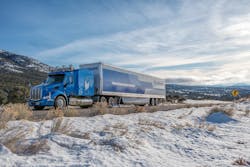Autonomous vehicles: Now on a more voluntary yet still uncertain glide path
Can rules be too rigid? The answer the U.S. Department of Transportation (DOT) is providing to that question – at least where the issue of self-driving vehicles is concerned – is a firm “yes.”
The DOT and the National Highway Traffic Safety Administration (NHTSA) yesterday released new federal guidance for Automated Driving Systems (ADS): A Vision for Safety 2.0, which is designed to provide a regulatory roadmap for the development of self-driving cars and trucks.
Again this is “voluntary guidance,” which is much different than the top-down regulatory control envisioned previously by the Obama administration, which focused on just Levels Three through Five as defined by SAE International, a global association of vehicle engineers formally known as the Society of Automotive Engineers. The five levels within the international standard for automated driving are:
- Level Zero: No Automation. The human does all the driving all the time.
- Level One: Driver Assistance. The vehicle’s system provides assistance with steering or acceleration and braking in certain circumstances, such as when something blocks the road.
- Level Two: Partial Automation. The system performs steering, acceleration and braking with a human monitoring the road and environment.
- Level Three: Conditional Automation. The system performs the driving tasks and monitors the environment while the human stands by to intervene if the system requests it.
- Level Four: High Automation. The system performs all driving tasks and can continue do so even if a human driver fails to intervene if requested.
- Level Five: Full Automation. The vehicle does all driving all the time.
As automated technologies advance, so will the DOT’s guidance, U.S. Transportation Secretary Elaine Chao noted in a speech yesterday; guidance that “is intended to be flexible and to evolve as technology does,” she said.
Despite all the usual platitudes about the wonders of technology – “The safe deployment of automated vehicle technologies means we can look forward to a future with fewer traffic fatalities and increased mobility for all Americans,” Chao said in her speech yesterday – the truth is we’re really in unknown territory.
Think about it: self-driving vehicles are literally the stuff of science fiction books and movies; literally. And now we’re actually moving into a position where this technology may become an everyday reality, with all sorts of seismic shock waves emanating from it.
Think about the truck drivers in this country for a second; a labor pool that totals some 3.5 million people, with 3.1 million of them commercial driver’s license (CDL) holders. What happens to them if trucks start driving themselves?
Chao herself touched on what a momentous point in time we’ve reached in terms of the development of autonomous vehicle systems in a speech she gave earlier this year.
“This is my third time back at the department [and] when I first came so many years ago, smart phones and drones were part of the Star-Trek universe. Well, they’re not science fiction anymore! Today, we are seeing a technological revolution that will change the way we work, live, travel, and conduct commerce,” she explained.
“Technology – the great disruptor—is creating a new type of transport based on digital, not human, command and control,” Chao pointed out. “In the future, computers, not people, will be in the driver’s seat. That means ‘self-driving’ cars, trucks, railroad cars, ships and drones. This technology has the potential to change our lives in ways we can’t imagine.”
No truer words were ever spoken, especially where autonomous vehicles are concerned.
